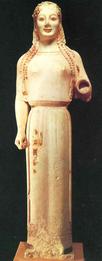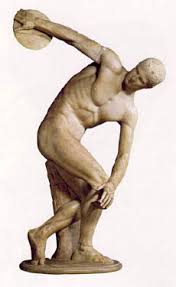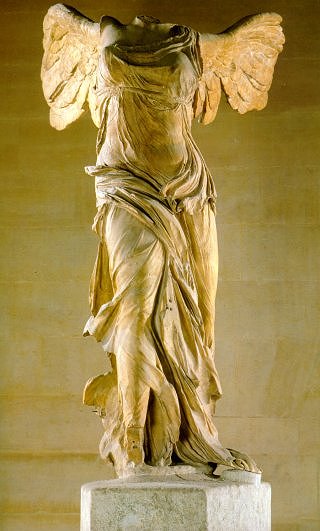Ancient Greek sculptures, composed mostly of marble or bronze, developed in phases from Archaic, Classical, and Hellenistic as the concept of the human figure evolved from abstract to realistic. The Ancient Greeks believed in sculpting the human figure for its own sake and of finding the body to be a worthy subject for art.
Further, in Classical Greek philosophy, they believed that human bodies are the “measure of all things,” as our bodies symbolize our divine soul. Likewise, moving our bodies through strengthening, stretching, and balancing became increasing important to the Greeks through the development of Olympic games and other physical activities.
Further, in Classical Greek philosophy, they believed that human bodies are the “measure of all things,” as our bodies symbolize our divine soul. Likewise, moving our bodies through strengthening, stretching, and balancing became increasing important to the Greeks through the development of Olympic games and other physical activities.
The physical postures (poses) of yoga, called asanas, are the third limb out of 8, of Pantajali’s Path to Enlightenment. It is while practicing yoga asanas that we learn the art of adjustment, and constantly redirecting our focus.
BKS Iyengar teaches, “Working on our alignment is like sculpting in which a piece of stone is constantly shaped and refined; but here the sculpture, the sculptor, and the act of sculpting is one and the same – our own selves. Moreover, the sculpture is not a static entity, but a dynamic one that changes over time; it tends to deteriorate if we don’t take a good care of it.”
Similarily, Philosopher Heraclitus instructs, "There is nothing permanent except change."
BKS Iyengar teaches, “Working on our alignment is like sculpting in which a piece of stone is constantly shaped and refined; but here the sculpture, the sculptor, and the act of sculpting is one and the same – our own selves. Moreover, the sculpture is not a static entity, but a dynamic one that changes over time; it tends to deteriorate if we don’t take a good care of it.”
Similarily, Philosopher Heraclitus instructs, "There is nothing permanent except change."
In the same way, the Greek philosopher Aristotle preaches that we must continuously strive to take good care of ourselves, “We are what we repeatedly do. Excellence then... is a habit.”
Yoga allows us to rediscover a sense of wholeness in our life, where we do not feel like we are constantly trying to fit broken pieces together. Alignment is the study of relationship; how everything is connected to everything else. BKS Iyengar famously proclaims, “It is through the alignment of my body that I discovered the alignment of my mind, self, and intelligence.”
Greek Philosopher and historian, Xenophon observes, "Fast is fine, but accuracy is everything." Constantly directing awareness to our alignment brings the most benefit to each position that we take with our bodies.
Let’s take a closer look at how alignment and philosophy can be found in each of these sculptures to help us take a journey inward towards our core.
Greek Philosopher and historian, Xenophon observes, "Fast is fine, but accuracy is everything." Constantly directing awareness to our alignment brings the most benefit to each position that we take with our bodies.
Let’s take a closer look at how alignment and philosophy can be found in each of these sculptures to help us take a journey inward towards our core.
Caryatids of Erechtheion
Between 421 and 406 BCE, Greek female figure statues evolved from the static korai figures (archaic) to an outstanding display of female power in the Classical Period. Voluptuous curves meet immense muscular strength as these new representations of Ionic columns are depicted looking casual and relaxed as they balance heavy stone roofs on their heads.
A Caryatid is a sculpted female figure taking the place of a column or a pillar. The most famous Caryatids are the six which support the roof of the false south porch of the Erechtheion on the Athenian acropolis.
These figures display a distribution of weight called contrapasto, in which the figure stands in an s-curve through a play of opposites. Although the marble remains stagnant, this posture shows that there is potential for motion inherent in each living being.
Between 421 and 406 BCE, Greek female figure statues evolved from the static korai figures (archaic) to an outstanding display of female power in the Classical Period. Voluptuous curves meet immense muscular strength as these new representations of Ionic columns are depicted looking casual and relaxed as they balance heavy stone roofs on their heads.
A Caryatid is a sculpted female figure taking the place of a column or a pillar. The most famous Caryatids are the six which support the roof of the false south porch of the Erechtheion on the Athenian acropolis.
These figures display a distribution of weight called contrapasto, in which the figure stands in an s-curve through a play of opposites. Although the marble remains stagnant, this posture shows that there is potential for motion inherent in each living being.
This position is similar to Tadasana Godmukhasana. Tadasana is our mountain pose, setting the foundation for all other poses. We stand tall with a long spine and the outer edges of our feet parallet (together for harder or hip width distance for easier). We activate the energy in our legs by pressing into the earth from all four corners of our feet. This should lift our knee cap and direct our tailbone down. Next, we tuck our ribs in and bring our chin parallel to the earth.
Gomukha is the name of a traditional musical instrument comparable to a horn or trumpet. We will make this shape with our arms. Lift your arms up to the sky and bend your left elbow. Rest your left hand on the back of your neck. Using your right hand, gently pull your left elbow back any amount to feel a tricep stretch or come into the bind by internally rotating your right arm down and behind your back, reaching your fingertips to grasp those of your left hand.
Consciously moving with your breath, bend one knee at a time to show contrapasto, feel you weight balance shift from one side of your body to the other. This contact with the earth is what we call our foundation. “You must fill every inch of your body with the asana from your chest and arms and legs to the tips of your fingers and toes so that the asana radiates from the core of your body and fills the entire diameter and circumference of your limbs. You must feel your intelligence, your awareness, and your consciousness in every inch of your body. (Light on Life, Iyengar) .” This posture improves our body awareness, stretches our triceps, loosens our hips, strengthens our core, and our elongates spine. Switch arms after 7 slow breaths.
Gomukha is the name of a traditional musical instrument comparable to a horn or trumpet. We will make this shape with our arms. Lift your arms up to the sky and bend your left elbow. Rest your left hand on the back of your neck. Using your right hand, gently pull your left elbow back any amount to feel a tricep stretch or come into the bind by internally rotating your right arm down and behind your back, reaching your fingertips to grasp those of your left hand.
Consciously moving with your breath, bend one knee at a time to show contrapasto, feel you weight balance shift from one side of your body to the other. This contact with the earth is what we call our foundation. “You must fill every inch of your body with the asana from your chest and arms and legs to the tips of your fingers and toes so that the asana radiates from the core of your body and fills the entire diameter and circumference of your limbs. You must feel your intelligence, your awareness, and your consciousness in every inch of your body. (Light on Life, Iyengar) .” This posture improves our body awareness, stretches our triceps, loosens our hips, strengthens our core, and our elongates spine. Switch arms after 7 slow breaths.
Disocbolus of Myron
Disocbolus of Myron is a perfect example of a transitory moment of action, expressing the moment of stasic just before the release, like a coiled spring being pressed together. His expressionless face does not reflect this tension. Through yoga postures, we recognize the importance of coming as we are, making adjustments to get the best variation of the pose that works with our body. We strive to find that peaceful expression, activating the parts of our body that need to strengthen and relaxing the places that can be relaxed, like our facial expression and even our tongue.
Disocbolus of Myron is a perfect example of a transitory moment of action, expressing the moment of stasic just before the release, like a coiled spring being pressed together. His expressionless face does not reflect this tension. Through yoga postures, we recognize the importance of coming as we are, making adjustments to get the best variation of the pose that works with our body. We strive to find that peaceful expression, activating the parts of our body that need to strengthen and relaxing the places that can be relaxed, like our facial expression and even our tongue.
This pose look very similar to the yoga pose commonly know as Twisting Chair. In Sanskrit it’s known as Parivrtta Utkatasana meaning revolved powerful pose. This pose tones and massages abdominal muscles and organs, lengthens the spine, strengthens the ankles and knees, and expands your chest.
In this pose, think root to rise. Bringing you big toes together, lift your toes and press your feet firmly into the ground. Squeeze your legs together as you sit down into a pretend chair, stacking your knees over your ankles, rather than your toes. Tuck your core in and be careful not to over-arch. Find a long spine as you bring your hands together at your heart’s center and lean forward. Wrap your left elbow over your right knee. Try to keep your knees and hips level and square without one protruding farther forward than the other. Gently reach your core, chest, neck and head slightly more to the right. Open your arms wide into a straight line, pressing your left arm against your right thigh, leveraging your twist a bit deeper. Hold for five to seven breaths then exhale and unwind. Switch sides.
If you feel too tight in your neck, shoulders, or lower back, here are some common modifications. If your shoulders and chest are tight you can keep your hands pushing together in Anjali Mudra. If it hurts your neck to gaze upward, turn your gaze to the floor, instead. If your back is tender you can try separating your feet hip-width apart and putting a block on its highest side between your feet. Press into the block with your bottom hand and stretch your top arm straight up, revolving your chest toward the top arm.
In this pose we focus on rooting to rise which means that after we find a firm foundations, we can bring our focus inward to find length and lightness with a balance of opposing energies, strengthening and stretching at the same time.
In this pose, think root to rise. Bringing you big toes together, lift your toes and press your feet firmly into the ground. Squeeze your legs together as you sit down into a pretend chair, stacking your knees over your ankles, rather than your toes. Tuck your core in and be careful not to over-arch. Find a long spine as you bring your hands together at your heart’s center and lean forward. Wrap your left elbow over your right knee. Try to keep your knees and hips level and square without one protruding farther forward than the other. Gently reach your core, chest, neck and head slightly more to the right. Open your arms wide into a straight line, pressing your left arm against your right thigh, leveraging your twist a bit deeper. Hold for five to seven breaths then exhale and unwind. Switch sides.
If you feel too tight in your neck, shoulders, or lower back, here are some common modifications. If your shoulders and chest are tight you can keep your hands pushing together in Anjali Mudra. If it hurts your neck to gaze upward, turn your gaze to the floor, instead. If your back is tender you can try separating your feet hip-width apart and putting a block on its highest side between your feet. Press into the block with your bottom hand and stretch your top arm straight up, revolving your chest toward the top arm.
In this pose we focus on rooting to rise which means that after we find a firm foundations, we can bring our focus inward to find length and lightness with a balance of opposing energies, strengthening and stretching at the same time.
If you’d like to learn more about Greek sculptures and how they relate to yoga poses and alignment, sign up for this exclusively FREE Gift with details and images of 3 more poses!
Also, grab a pair of my newest leggings design, a watercolor and ink rendering of the Caryatids of Erechtheion!











